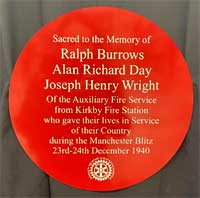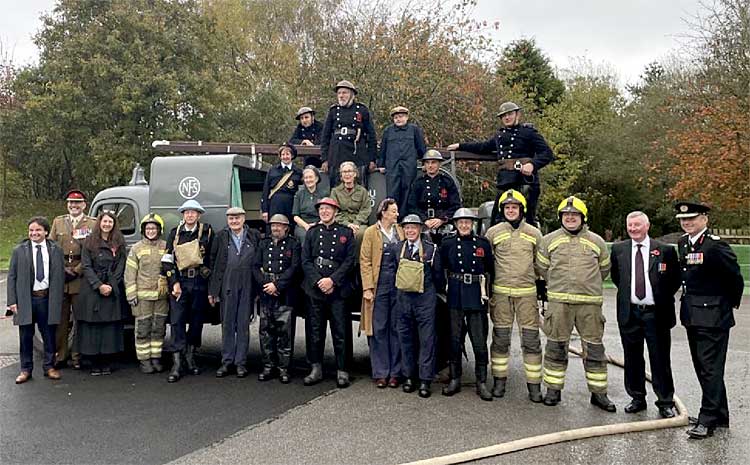Articles from the Thoroton Society Newsletter
History of Fire Fighting in the Second World War
By David Needham
 The Memorial to three of the Auxiliary Fire Service who were killed in December 1940.
The Memorial to three of the Auxiliary Fire Service who were killed in December 1940.On 2nd November 2024, David Needham unveiled a plaque at Ashfield Fire Station in Nottinghamshire. The plaque commemorates three Firemen from Kirkby who were killed during an air raid on Manchester during a series of heavy attacks on the city in December 1940.
David was chosen because of his extensive research about Nottinghamshire Fire Service during World War Two. The research first began in 1990 and led to a book on the subject titled Battle of the Flames. The book was revised in 2020 and new chapters and photographs added for the second edition.
Reproduced below is the speech that David gave before unveiling the plaque.
Lord Lieutenant, Deputy Lord Lieutenant, Chief Fire Officer, Distinguished guests, ladies and gentlemen.
It is an honour to speak to you today and to be able to tell you some of the history of the fire service in Nottinghamshire.
Before the Second World War, fire services varied greatly in the way that firefighting was organised. They tended to be quite parochial with only a few mutual assistance schemes set up by brigades. The Auxiliary Fire Service was formed to provide support to the regular fire brigades in times of war. It was always intended that Auxiliary Fire Services would be used to provide support in towns and cities affected by air raids. The crews not only had to fight fires whilst bombs were falling but they were also directly fired upon as Luftwaffe crews strafed them with machine gun and cannon fire. Although they were classed as non-combatants they were always seen as legitimate targets.
As a result of the massive daylight air raids on London in early September 1940, crews from Nottinghamshire were sent as part of the regional reinforcement scheme.
The air raids switched to night-time bombing and this has subsequently been referred to as The Blitz.
Herbert Morrison, the Minister for Home Security said in a speech:
There is a battle being fought that is just as importantfor the outcome of the war as any battle of tanks in the Middle East or of ships in the Atlantic. It is the battle against fire and high explosives ...
He referred to this as the 'Battle of the Flames'. It was exactly that.
You did not need to be a soldier, a sailor, or aircrew to be in the front line, it would come to visit you in your own town, your own street, your own home. It was this struggle that the Fire Service and Civil Defence were engaged in night after night.
By November 1940 many firemen from Nottinghamshire had been injured and three had been killed, including one during the infamous raid on Coventry on 14th November.
The Fire Service and Civil Defence were considered to be the Fourth Arm’ but for these people there are no regimental colours with campaign honours on a flag. Nonetheless, they served in some of the longest and most difficult campaigns. Their ‘Home Front Campaign ’ can be spoken of with pride and for these Nottinghamshire men and women their campaign honours are:
Thameshaven & Purfleet, London, Birmingham, Coventry, Sheffield, Liverpool, Manchester & Stockport, Northern Ireland, Nottingham, Grantham, Grimsby, Hull, the South Coast preparations for D-Day and Operation Colour Scheme for the overseas contingent.
I now want to turn to a particular Battle of the Flames’ that has brought us together here 84 years later.
On Sunday 22nd December 1940, wireless transmissions by the Luftwaffe were decoded at Bletchley Park. The target that night was Manchester.
The attack began just after 7.30pm and continued until 7am the next morning. 270 aircraft took part in the raid — they were guided to the general area by the glow of fires still burning in Liverpool from the raids of the previous two nights.
Firemen from Nottinghamshire were amongst those still tackling those fires.
The aircraft dropped 272 tonnes of high explosive bombs and 37,000 incendiaries on Manchester. The fire crews had an insurmountable task to control over 400 fires that were consuming entire blocks of buildings.
The people of Nottinghamshire were in their shelters all night whilst the vast fleet of aircraft trooped across the night sky to Manchester- some bombs had even been dropped in the county. People had heard the anti-aircraft guns firing shells at the raiders, little knowing that their own firemen, who were working alongside those in Manchester were being gradually overwhelmed by the massive attack on the city.
Bert Dickson, a fireman from Bulwell fire station in Nottingham, had a lucky escape whilst firefighting on the Metro-Vickers factory in Manchester. A one kilogram incendiary bomb hit him and glanced off his steel helmet. In other instances where someone was struck by an incendiary bomb, it often proved fatal. How he escaped a broken neck from the force of the impact was sheer chance.
During the raid, Albert Cooke, one of Nottinghamshire’s firemen from Beeston, was seriously injured. He was treated in hospital at Manchester and was eventually returned home, but he subsequently died of his injuries.
Three Nottinghamshire firemen from Kirkby, Ralph Burrows, Joseph Wright, and Alan Day, were killed on 23rd December during the raid on Manchester. Ralph was killed in Barker Street, Piccadilly, and Joe was killed just a short distance away in Back George Street, Piccadilly. Alan was seriously injured and taken to the Roby Street Infirmary just a few hundred yards away. He died there of his injuries during the night.
Ronald Lowe, William Makinson and George Best, also from Kirkby Fire Station were seriously injured. Ronald and William were taken to Manchester Royal Infirmary, but George was taken almost all the way home, to Mansfield General Hospital.
Manchester was attacked again on the night of 23rd December. As darkness fell, and aircraft headed Northwest, they could see the glow that was Manchester from as far away as London. The city was bombed unopposed for five hours. Some of the crews just released their bombs where they could see the glow of fires in the target area. It was a tactic intended to make the fire crews retreat. But they did not - they stood their ground.
The two massive raids on Manchester had been devastating with around 50,000 properties being damaged and 600 people killed. Six conflagrations were recorded by the fire brigade control, as well as 20 major fires and 600 smaller fires. There had been over 100 casualties amongst the firemen - 26 of them had been killed.
50 pumps and 2 turntable ladders had been put out of action and they were badly needed in the fight for survival as city after city was becoming involved.
By 2 pm on Christmas Eve, the fires were under control but not yet fully extinguished.
We should also remember the families of these men who knew their relatives were in the front line of this battle. They often found themselves not knowing where theirf iremen had gone, or for how long. They usually went without any notice, and some were away for months with only a postcard being allowed to send to their families informing them that they had been 'Posted Away'.
Those whose service came after the Second World War have carried on the traditions of dedication, skill and sacrifice in the Fire & Rescue Service for the greater good of the communities they serve. We can be proud of the continuation of this service to the present day.
The three men commemorated on this memorial died whilst firefighting and protecting our communities. They were civilians in the Auxiliary Fire Service and led ordinary lives as their neighbours and friends did, as you and I do.
Ralph Burrows
Alan Day
Joseph Wright
During the Blitz Winston Churchill referred to firemen as “Heroes with Grimy Faces”
After the speech, the air raid siren ‘Alert’ signal sounded to start one minute’s silence which was ended by the sounding of the ‘All clear’ signal or ‘Raiders passed” as it was sometimes referred to.
A display of wartime style firefighting took place later in the afternoon with the National Fire Service Display Group using original fire engines, equipment and some uniform items to create an authentic look.
The group used three types of fire appliance, which included a 1943 Turntable Ladder.
The display was enthusiastically welcomed by the spectators and there were even cheers when the ‘National Fire Service’ arrived to tackle the fires and rescue the workers in the ‘factory’ who were trapped.
 Nottingham Fire Crew 1 and guests (photo by David Needham).
Nottingham Fire Crew 1 and guests (photo by David Needham).< Previous